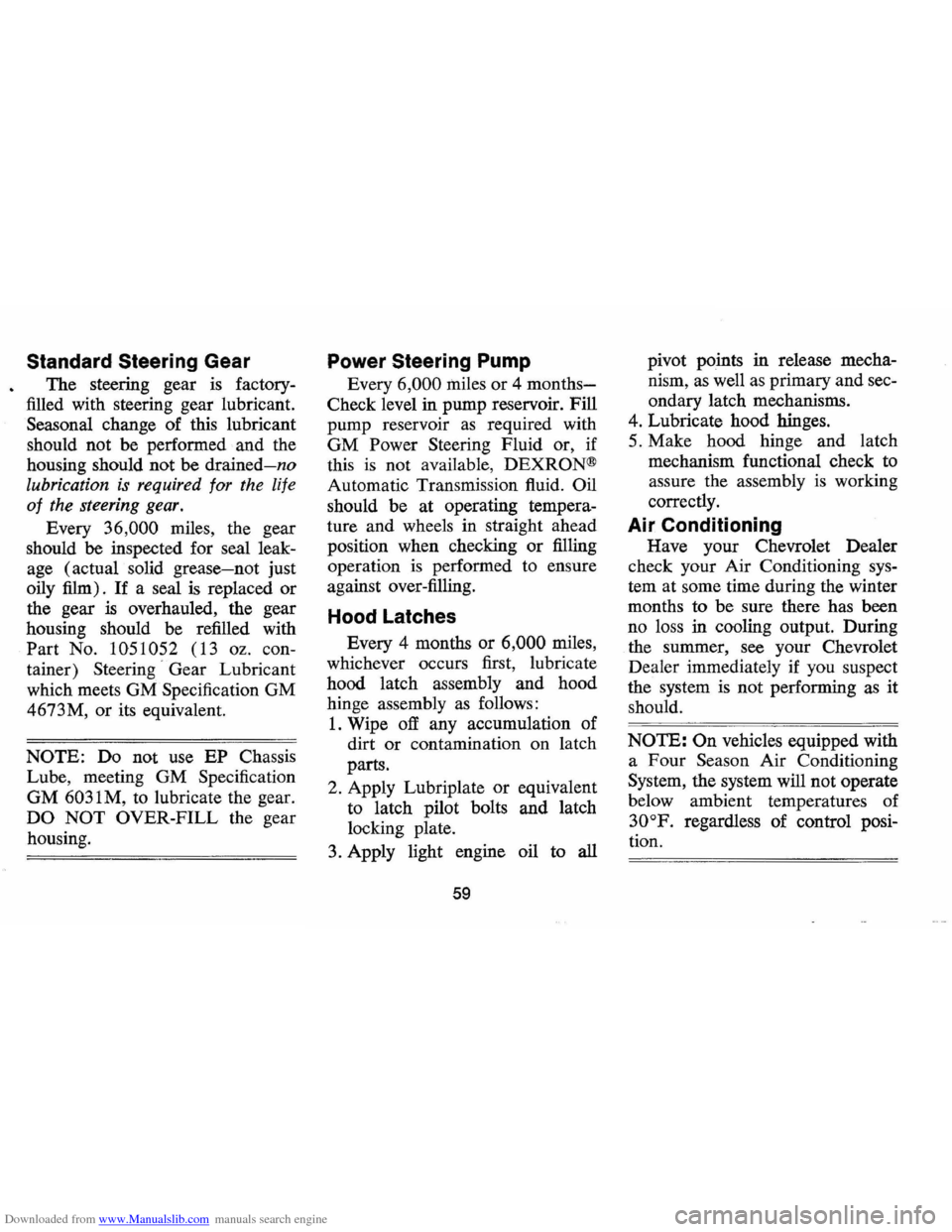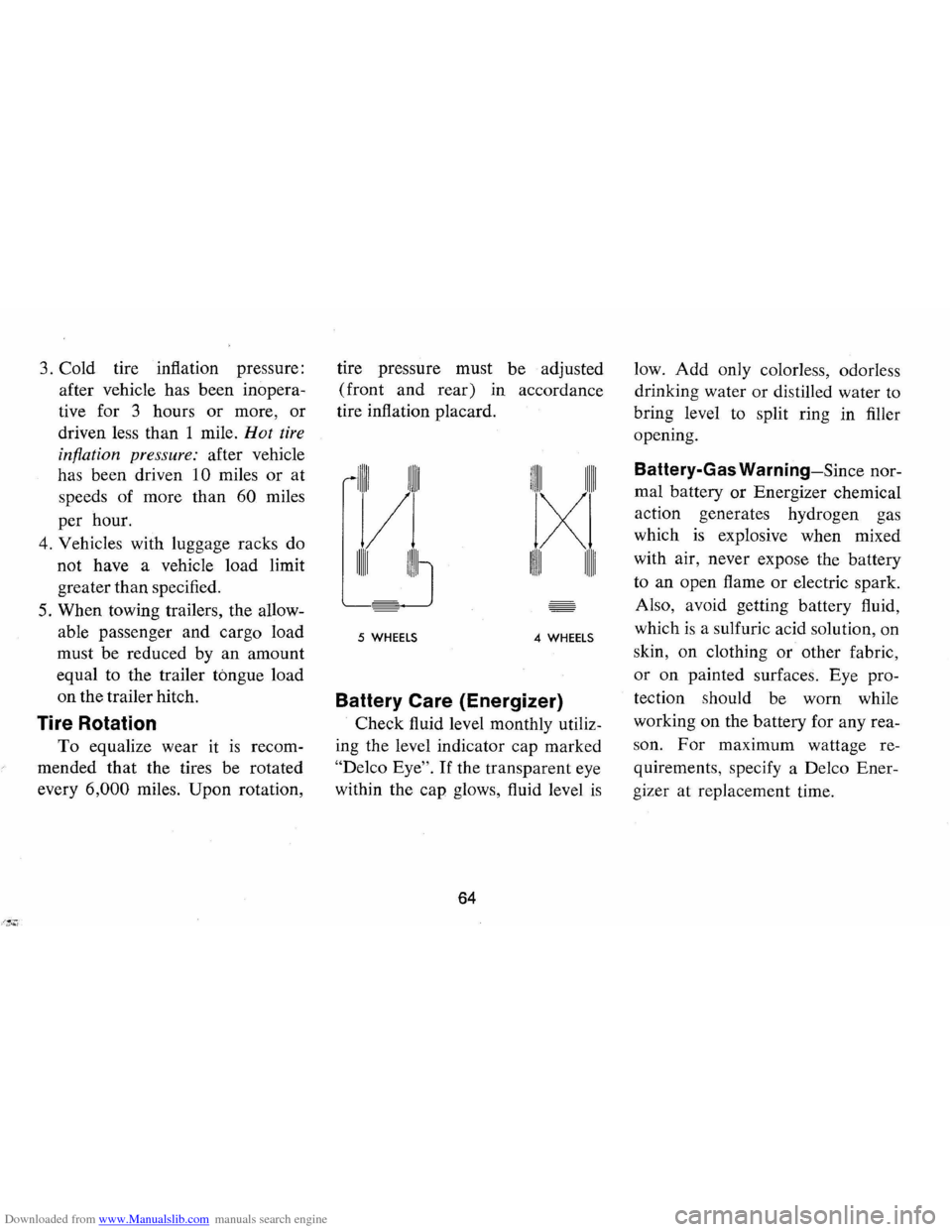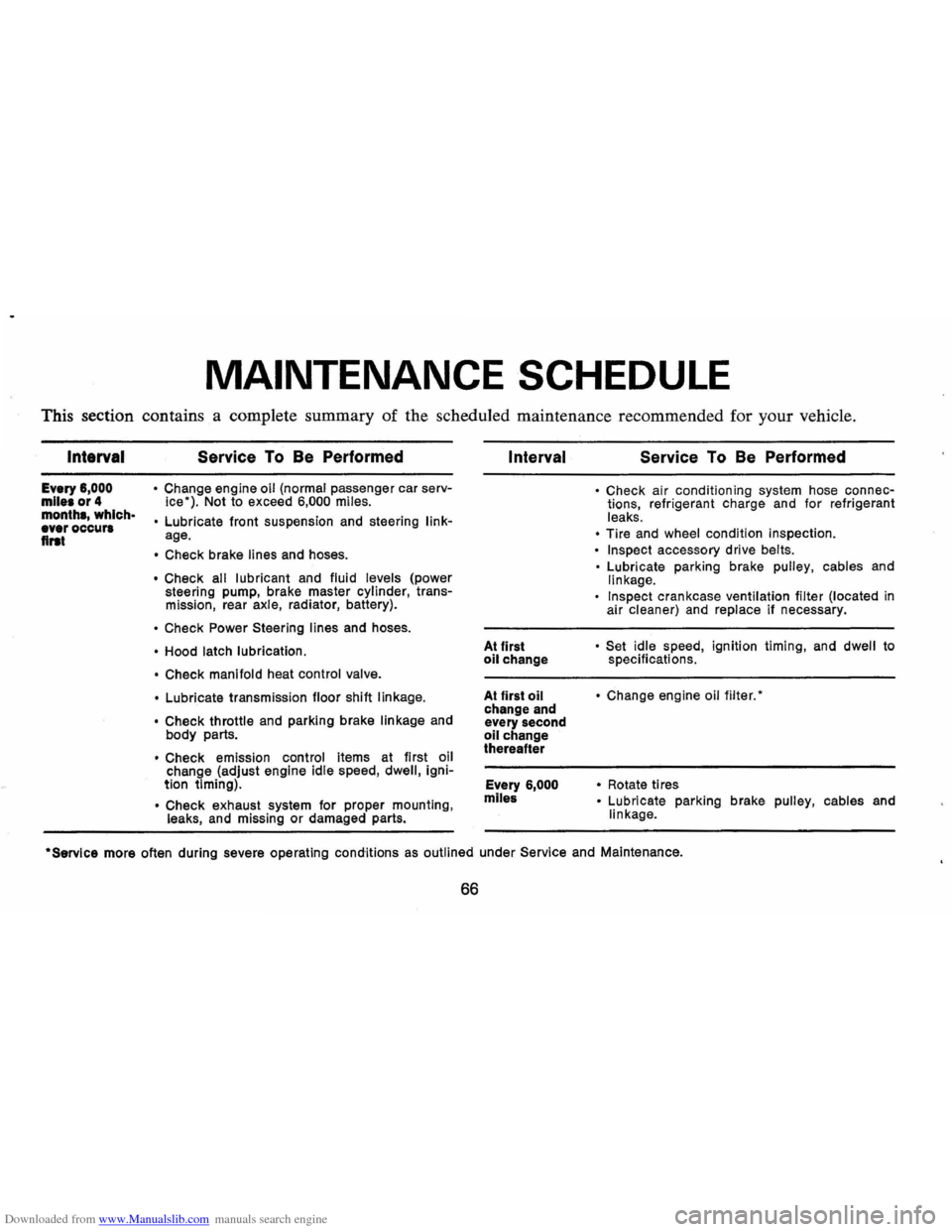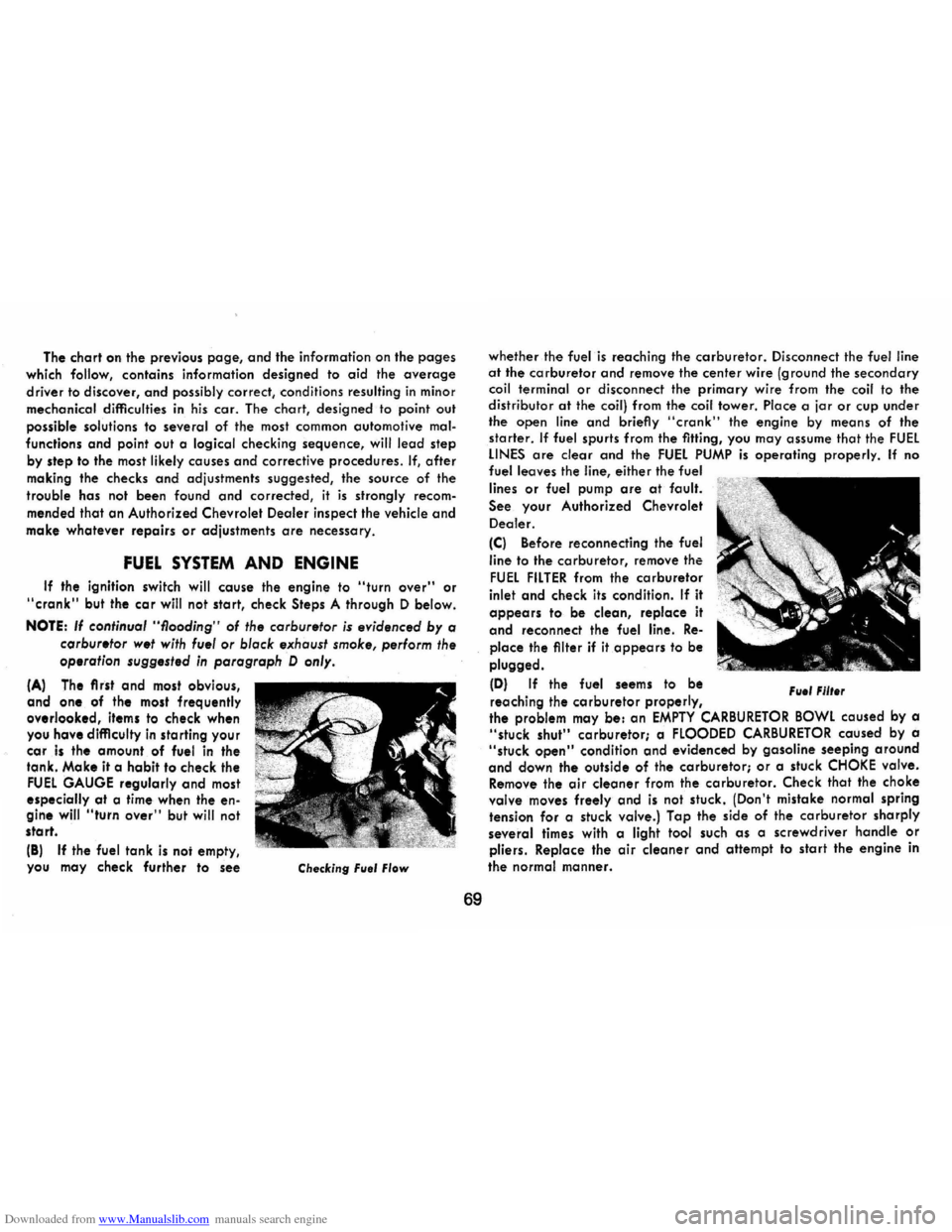1971 CHEVROLET CAMARO check engine
[x] Cancel search: check enginePage 62 of 88

Downloaded from www.Manualslib.com manuals search engine Standard Steering Gear
The steering gear is factory
filled with steering gear lubricant.
Seasonal change of this lubricant
should not be performed
and the
housing should
not be drained-no
lubrication
is required for the life
of the steering gear.
Every 36,000 miles, the gear
should be inspected for seal leak
age (actual solid
grease-not just
oily film).
If a seal is replaced or
the gear is overhauled, the gear
housing should be refilled with
Part No. 1051052 (13 oz. con
tainer)
Steering ' Gear Lubricant
which meets
GM Specification GM
4673M, or its equivalent.
NOTE: Do not use EP Chassis
Lube, meeting
GM Specification
GM 6031 M, to lubricate the gear.
DO NOT OVER-FILL the gear
housing.
Power Steering Pump
Every 6,000 miles or 4 months
Check level in pump reservoir. Fill
pump reservoir
as required with
GM Power Steering Fluid or, if
this
is not available, DEXRON®
Automatic Transmission fluid.
Oil
should be at operating tempera
ture
and wheels in straight ahead
position when checking
or filling
operation is performed to ensure
against over-filling.
Hood Latches
Every 4 months or 6,000 miles,
whichever occurs first, lubricate
hood latch assembly
and hood
hinge assembly as follows:
1. Wipe off any accumulation of
dirt
or contamination on latch
parts.
2. Apply Lubriplate
or equivalent
to latch pilot bolts
and latch
locking plate.
3. Apply light engine oil to
all
59
pivot points in release mecha
nism, as well as primary
and sec
ondary latch mechanisms.
4. Lubricate hood hinges.
5. Make hood hinge
and latch
mechanism functional check to
assure the assembly is working
correctly.
Air Conditioning
Have your Chevrolet Dealer
check your Air Conditioning sys
tem at some time during the winter
months to
be sure there has been
no loss in cooling output. During
the summer, see your Chevrolet
Dealer immediately if you suspect
the system is
not performing as it
should.
NOTE: On vehicles equipped with
a
Four Season Air Conditioning
System, the system will not operate
below ambient temperatures of
30oP. regardless of control posi
tion.
Page 63 of 88

Downloaded from www.Manualslib.com manuals search engine Cooling System Care
Checking the coolant level at
each engine oil change. Level
should be
3" below bottom of filler
neck when cold.
Coolant Recommendations
The inhibited year-around cool
ant, used to
fill the cooling system
at the factory,
is a high quality so
lution that meets General Motors
Specifications 1899-M. This fac
tory-fill coolant solution
is formu
lated to withstand two full calendar
years of normal operation without
draining, provided the same con
centration of coolant
is added if the
system needs additional fluid be
tween drain periods. The original
factory-fill coolant provides freez
ing protection to
-20°F (-32°F
in Canada).
Every two years, the cooling sys
tem should be serviced as follows:
1. Drain coolant, when hot,
through the radiator drain valve.
2. Close valve and add sufficient
plain· water to
fill system.
3. Run engine until normal operat
ing temperature
is reached.
4. Drain and refill the system as
described in steps 1, 2, and 3 a
sufficient number of times until
the drained liquid
is colorless.
5. Allow system to drain com
pletely and then close radiator
drain valve tightly.
6.
Add the necessary amount of
high quality inhibited glycol
base coolant meeting GM
Speci
fication 1899-M to provide the
required freezing and corrosion
protection
(at least to O°F.)
7. Run engine until normal oper
ating temperature
is reached.
8. Check and adjust level of cool
ant after system has cooled
suffi
ciently to remove radiator cap.
60
NOTE: Addition of supplemental
additives and other available ma
terials which have not been specifi
cally approved by GM are not nor
mally required in your car. Use of
these materials will result in un
warranted operating expense.
It is the owner's responsibility to
keep the freeze protection at a level
commensurate with the tempera
tures which may occur in the area
in which the vehicle will be oper
ated. Regardless of whether freez
ing temperatures are
or are not ex
pected, cooling system protection
should be maintained at least to
OaF to provide adequate corrosion
protection. When coolant addi
tions are required because of cool
ant loss or to provide additional
protection against freezing at tem
peratures lower than
-20°F,
(-32°F in Canada), a sufficient
amount of an ethylene glycol base
Page 64 of 88

Downloaded from www.Manualslib.com manuals search engine • coolant meeting GM Specification
1899 M should be used.
NOTE: Alcohol or methanol base
coolants or plain water are not rec
ommended for your Camaro at
any time.
Radiator Pressure Cap
The radiator cap, a 15 lb. pres
sure type, must be installed tightly,
otherwise coolant may be lost and
damage to engine may result from
overheating.
Radiator pressure
caps should be checked periodi
cally for proper operation.
If re
placement
is required specify AC.
Thermostat
The cooling system is protected
and controlled by a thermostat in-stalled
in the engine coolant outlet
to maintain a satisfactory operat
ing temperature of the engine. This
thermostat
is designed for continu
ous use through both winter and
summer and need not be changed
seasonally. When replacement
is
necessary, specify United Delco
parts.
Tires
The factory installed tires on
your car are selected to provide the
best all around tire performance
for all normal operation. When in
lated
as recommended in the tire
inflation placard affixed to the left
door of your vehicle, they have the
load carrying capacity to operate
satisfactorily at all loads up to and
including the full rated load speci-
61
fied in that table at all normal high
way speeds. In addition, for those
owners who prefer the utmost in
comfort, optional tire inflation
pressures may be used when loads
of four passengers or less are
carried.
For the added convenience of
owners, many Chevrolet dealers
are equipped to handle tire war
rantyadjustments on certain makes
of tires provided on 1971 Chevro
let cars.
TIRE TRACTION
A decrease in driving, corner
ing, and braking traction occurs
when water, snow, ice, gravel, or
other material
is on the road sur
face. Driving practices and car
speed should be adjusted to the
road conditions.
Page 65 of 88

Downloaded from www.Manualslib.com manuals search engine When driving on wet or slushy
roads, it
is possible for a wedge of
water to build up between the tire
and road surface. This phenome
non, known as hydroplaning, may
cause partial or complete loss of
traction, which adversely affects
vehicle control and stopping abil
ity.
To reduce the possibility of
traction loss, the following pre
cautions should be observed:
1. Slow down during rainstorms or
when roads are slushy.
ENGINE AND BODY
2. Slow down if road has standing
water or puddles.
3. Replace tires when tread wear
indicators are visible. (See
Safety Checks section.)
4. Keep tires properly inflated.
For temporary assistance when
traction
is lost on ice or snow, the
use of
AC Liquid Tire Chain is
recommended.
Optional Tires
Only those tires of the size shown
STANDARD
on the following table are recom
mended for use on your Camaro.
Use of any other size tire may seri
ously affect ride, handling, ground
clearance, tire clearance and speed
ometer calibration.
To achieve best
all around vehicle handling per
formance, belted-bias tires and
bias ply tires should not be mixed
on the same car. Because of possi
ble adverse effects
on vehicle han
dling, do not mix radial ply tires
with other type tires on the same
vehicle.
OPTIONAL
ALL (Except SS or Z28 Models) I "ss" Z28
E78 x 14 F70 x 14 White Letters F60 x 15 White Letters Stripe or White Letters
I
F70 x 14 White
All
Standard and Optional Tires are Load Range B.
Inflation Pressure
The tire inflation pressures listed
on the tire placard affixed to the
left front door of your vehicle have been
selected to provide you with
the best tire life and riding comfort
over the full range of normal driv
ing conditions.
62
The use of improper tire infla
tion pressures can affect tire life
and load carrying capacity. Infla
tion pressures should be checked at
Page 67 of 88

Downloaded from www.Manualslib.com manuals search engine 3. Cold tire inflation pressure:
after vehicle has been inopera
tive for 3 hours
or more, or
driven less than 1 mile. Hot tire
inflation pressure:
after vehicle
has been driven
10 miles or at
speeds of more than
60 miles
per hour.
4. Vehicles with luggage racks do
not have a vehicle load limit
greater than specified.
5. When towing trailers, the allow
able passenger and cargo load
must be reduced by
an amount
equal to the trailer tongue load
on the trailer hitch.
Tire Rotation
To equalize wear It IS recom
mended that the tires be rotated
every
6,000 miles. Upon rotation, tire
pressure must be adjusted
(front
and rear) in accordance
tire inflation placard.
1IIII1 1IIII1
/
IIIIII IIIIIJ
1IIII1 111111
IXl
1IIII1 111111
5 WHEELS 4 WHEELS
Battery Care (Energizer)
Check fluid level monthly utiliz
ing the level indicator cap marked
"Delco Eye". If the transparent eye
within the cap glows, fluid level
is
64
low. Add only colorless, odorless
drinking water
or distilled water to
bring level to split ring in filler
opening.
Battery-Gas Warning-Since nor
mal battery
or Energizer chemical
action generates hydrogen gas
which
is explosive when mixed
with air, never expose the battery
to an open flame
or electric spark.
Also, avoid getting battery fluid,
which
is a sulfuric acid solution, on
skin, on clothing
or other fabric,
or on painted surfaces. Eye pro
tection should be worn while
working on the battery for any rea
son.
For maximum wattage re
quirements, specify a Delco Ener
gizer at replacement time.
Page 69 of 88

Downloaded from www.Manualslib.com manuals search engine MAINTENANCE SCHEDULE
This section contains a complete summary of the scheduled maintenance recommended for your vehicle.
Intarval
Every 6,000 mile. or 4 month., which· ever occur. flrat
Service To Be Performed
• Change engine oil (normal passenger car serv
ice"). Not to exceed 6,000 miles.
•
Lubricate front suspension and steering linkage.
• Check brake lines and hoses.
• Check all lubricant and fluid levels (power
steering pump, brake master cylinder, transmission, rear axle, radiator, battery).
• Check Power Steering lines and hoses.
• Hood latch lubrication.
• Check manifold
heat control valve.
•
Lubricate transmission floor shift linkage.
• Check
throttle and parking brake linkage and
body parts.
• Check emission control items at first oil
change (adjust engine idle speed, dwell, ignition timing) .
• Check exhaust system for proper mounting , leaks, and missing or damaged parts.
Interval
At first oil change
At first
oil change and
every second
oil change
thereafter
Every
6,000
mlle&
Service To Be Performed
• Check air conditioning system hose connections, refrigerant charge and for refrigerant
leaks.
• Tire and wheel condition inspection.
• Inspect accessory drive belts.
•
Lubricate parking brake pulley, cables and linkage.
Inspect crankcase ventilation filter (located in
air cleaner) and replace if necessary.
• Set idle speed , ignition timing, and dwell to
specifications.
• Change engine oil filter."
•
Rotate ti res • Lubricate parking brake pulley, cables and
linkage .
·Servlce more often during severe operating conditions as outlined under Service and Maintenance.
66
Page 70 of 88

Downloaded from www.Manualslib.com manuals search engine Interval
First 12,000 miles Every 12
months
or 12,000 miles
Every
24,000 miles
Service To Be Performed
• Rotate distributor cam lubricator. See 24,000 mile recommendation.
• Insp .ect air cleaner element, if satisfactory
rotate 1800 from original position and reinstall. See 24,000 mile recommendation.
• Inspect brake linings and check system for
leaks
• Inspect parking brake and throttle linkage. • Engine tune-up.
Replace carburetor 'Inlet fuel filter element. • Check emission control items. • Inspect AIR drive belt.
Evaporation Control System-Replace filter in
base of canister and inspect canister. • Check headlamp aiming.
• Repack front wheel bearings.
• Replace distributor cam lubricator. • Drain automatic transmission sump and add
fresh fluid (normal passenger car service).' Adjust Powerglide low band at first fluid
change.
• Replace crankcase ventilation filter (located
within air cleaner).
• Replace Turbo Hydra-Matic sump filter.
Interval Service To Be Performed
Every 2 years • Drain radiator coolant, flush and refill system.
Every
24 months· Replace PCV Valve. Inspect all hoses and or 24,(100 miles fittings.
Every
36,000 • Check steering gear for seal leakage (actual
miles solid grease-not just oily film).
• Lubricate clutch cross shaft (sooner if necessary), remove plug and install lube fittIng.
During Winter
• Check operation of air conditioning system.
months
Periodically • Check battery liquid leve/.
• Inspect seat belts, buckles, retractors and
anchors.
• Check all lights for proper operation.
As Required
• Check wheel alignment and balancing.
'Service more often during severe operating conditions as outlined under Service and Maintenance.
67
Page 72 of 88

Downloaded from www.Manualslib.com manuals search engine The chart on the previous page, and the information on the pages
which
follow, contains information designed to aid the average
driver to discover, and possibly correct, conditions resulting in minor
mechanical
difficulties in his car. The chart, designed to point out
possible solutions to several of the most common automotive mal
functions and point out a logical checking sequence, will lead step
by step to the most likely causes and corrective procedures. If, after
making the checks and adjustments suggested, the source of the
trouble has not been found and corrected, it is strongly recom
mended that an Authorized Chevrolet Dealer inspect the vehicle and
make whatever repairs
or adjustments are necessary.
FUEL SYSTEM AND ENGINE
If the ignition switch will cause the engine to "turn over" or
"crank" but the car will not start, check Steps A through D below.
NOTE:
If continual "Rooding" of the carburetor is evidenced by a
carbur.tor wet with
fuel or black exhaust smoke, perform the
operation suggested in paragraph D only.
(A) The first and most obvious,
and one of the most frequently overlooked, items to check when
you have difficulty in sta rting you r car is the amount . of fuel in the
tank. Make it a habit to check the FUEL GAUGE regularly and most especially at a time when the engine will "turn over" but will not
start.
(8)
If the fuel tank is noi empty,
you may cheek further to see Checking Fllel Flow
69
whether the fuel is reaching the carburetor. Disconnect the fuel line at the carburetor and remove the center wire (ground the secondary coil terminal or disconnect the primary wire from the coil to the distributor at the coil) from the coil tower. Place a jar or cup under
the open line and briefly "cronk" the engine by means of the
starter. If fuel spurts from the fitting, you may assume that the FUEL LINES are clear and the FUEL PUMP is operating properly. If no fuel leaves the line, either the fuel
lines
or fuel pump are at fault.
See. your Authorized Chevrolet
Dealer.
(C) Before reconnecting the fuel
line
to the carburetor, remove the
FUEL FILTER from the carburetor
inlet and check its condition. If it
appears to be clean, replace it
and reconnect the fuel line. Re
place the filter if it appears to be
plugged.
(D) If the fuel seems to be
reaching the
carburetor properly, File' Fllt.r
the problem may be: an EMPTY CARBURETOR BOWL caused by a "stuck shut" carburetor; a FLOODED CARBURETOR caused by a "stuck open" condition and evidenced by gasoline seeping around
and down the outside of the carburetor; or a stuck CHOKE valve. Remove the air cleaner from the carburetor. Check that the choke valve moves freely and is not stuck. (Don't mistake normal spring
tension for a stuck valve.) Tap the side of the carburetor sharply
several times with a light tool such as a screwdriver handle or pliers. Replace the air cleaner and attempt to start the engine in
the
normal manner.